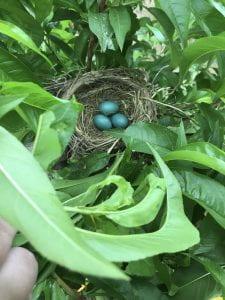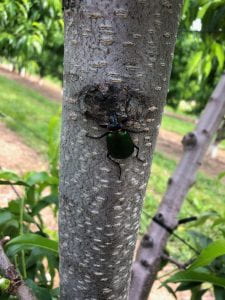Hey y’all, welcome back to the blog. This week, I wanted to talk about a peach experiment that I briefly mentioned in my last blog post. These peach trees were planted in 2014, so the block of peaches is aptly named “P14”. The experiment is a rootstock trial that spans a three year period and this is the last year they are collecting data.
The peaches are planted on about five different rootstocks, such as Bailey and Lovell. Additionally, they are all the same variety: Coral Star. There are five rows of peaches in this experiment, each row being 79 trees long, with only one guard row due to some technical difficulties in orchard planning. The trees were grown in a Quad V formation, meaning that they have two scaffolds per side, creating four scaffolds.
In regards to experiment set-up, each plot of trees was five trees, and each row was a new replicate. From the five trees in each plot, only the best two were data trees.
In order to maintain good orchard maintenance, like most trees, these needed to be pruned. Megan and I were given this task at the beginning of June and worked on it on and off until the first of July, so it felt like it took and eternity. In addition, the trees are so tall, that we needed to prune them from the ground and we also needed to use the N. Blosi, which is a scissor lift platform, but with an expanding platform on either side. Needless to say, Megan and I were (very) relieved when we finished. Below, I will put some pictures of some of the cool creatures we found while pruning.
To add to the fun, nutrient samples needed to taken from the leaves and soil. To collect the leaves, I was sent out to pick fifty leaves from waist to top-of-hand height from mid-shoot from each plot. I then put them in correctly labeled brown paper bags and put them on a greenhouse bench to dry out. For the soil samples, I had to collect a sample from each tree in the plot, put them in a bucket, mix them together, and scoop about two cups worth into another correctly labeled brown paper bag. They were also put in the greenhouse to dry. The sad thing about that step was that some of the soil was too heavy for the brown paper bags and they ripped. I had to go collect more samples. It was not a good day in my book. A couple weeks later, the samples were taken up to Penn State Main Campus and they had nutrient testing done on them.
Then, on August first, we did our first harvest. The peaches were picked into correctly tagged crates and then we ran them through our grader, which counts, weighs, and categorizes them. Then, the data is collected and the peaches are packaged for sale. Our second harvest, which was our largest, was done on August fifth. Unfortunately, our grader broke and the counts, weights, and measures had to be done all by hand. It was torturous work. Luckily, I had already scheduled two days off, so I got to miss that load of fun. The third harvest was done on August ninth, Most of the trees had been stripped in the second harvest, so it was the easiest to pick. By then, the grader had been fixed and we were back in business. This completed the seemingly never-ending arduous task of P14, but it was quite rewarding in the end.
In my next (and last) blog post, I wanted to sum up my experience at FREC and everything I have learned this summer.


